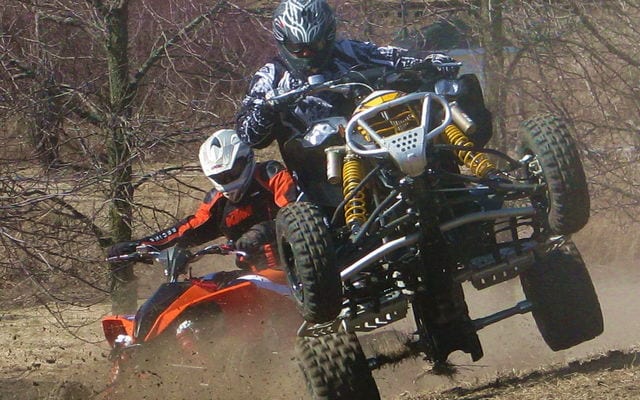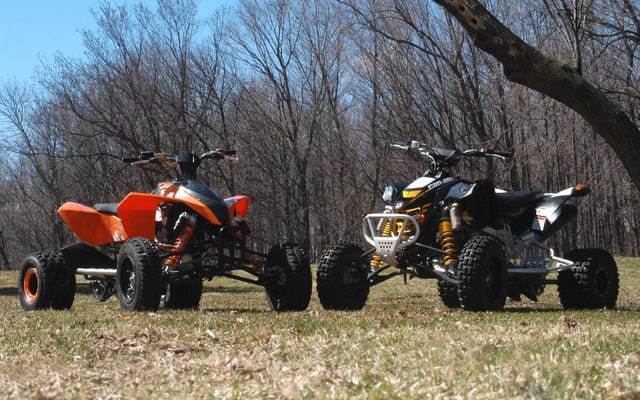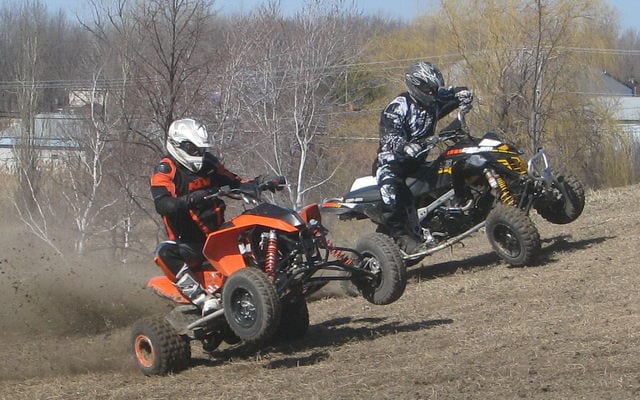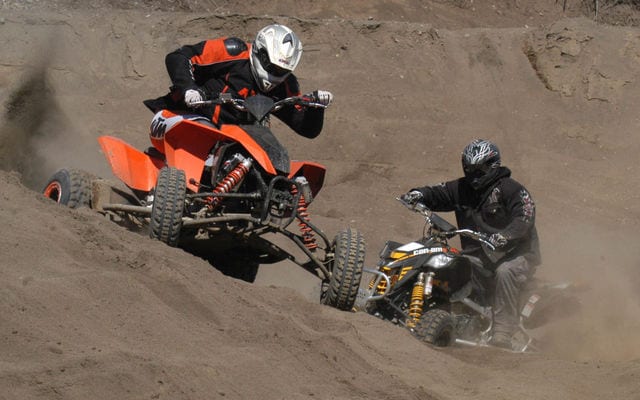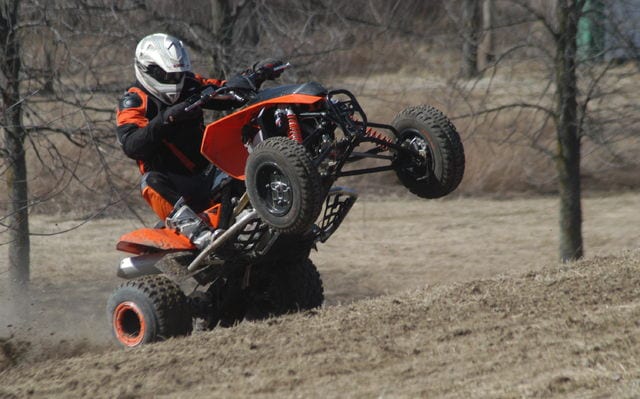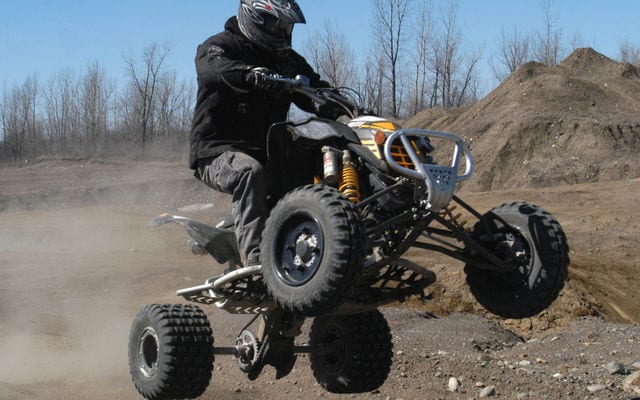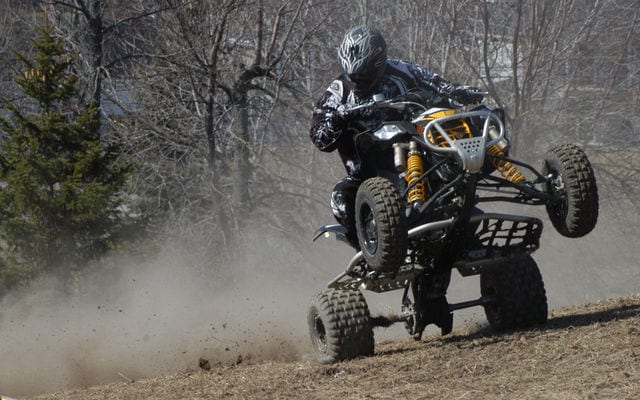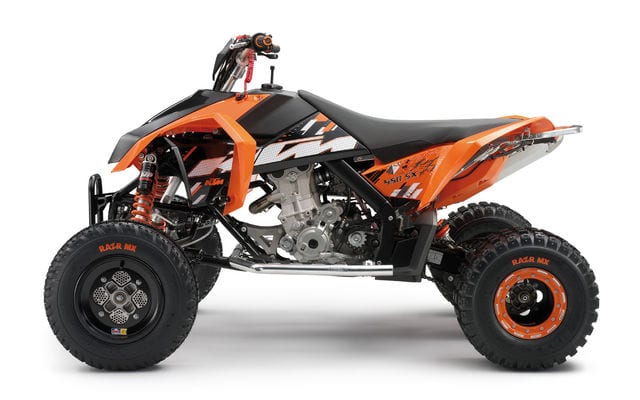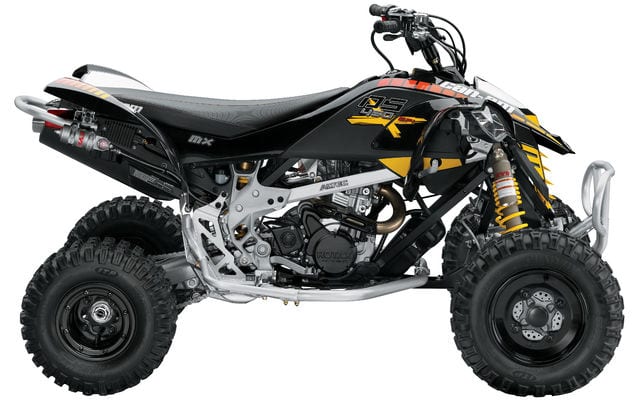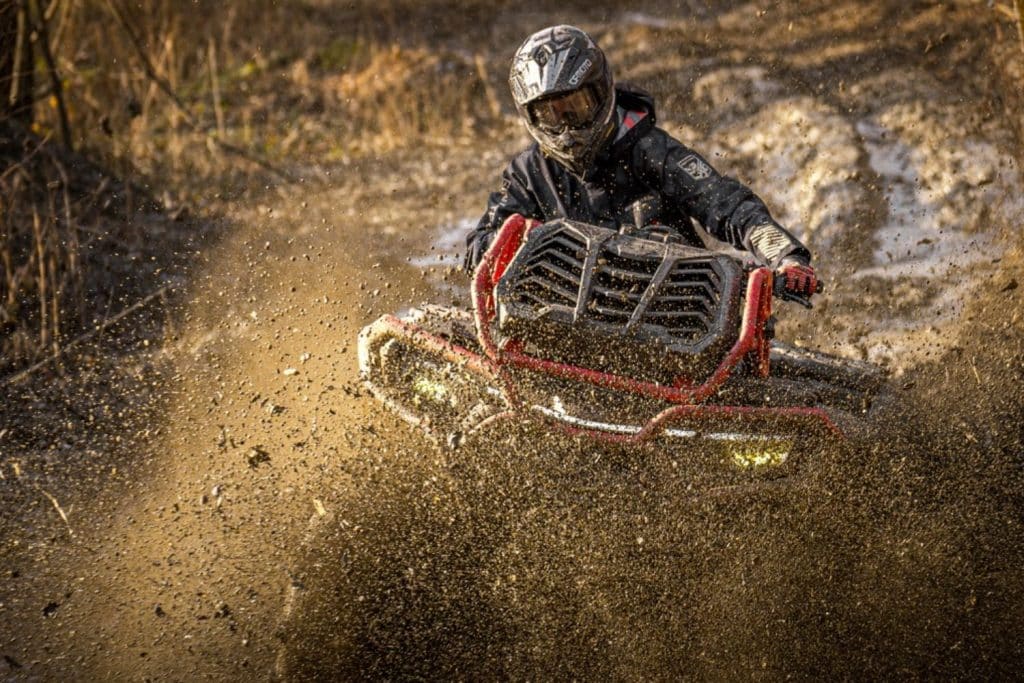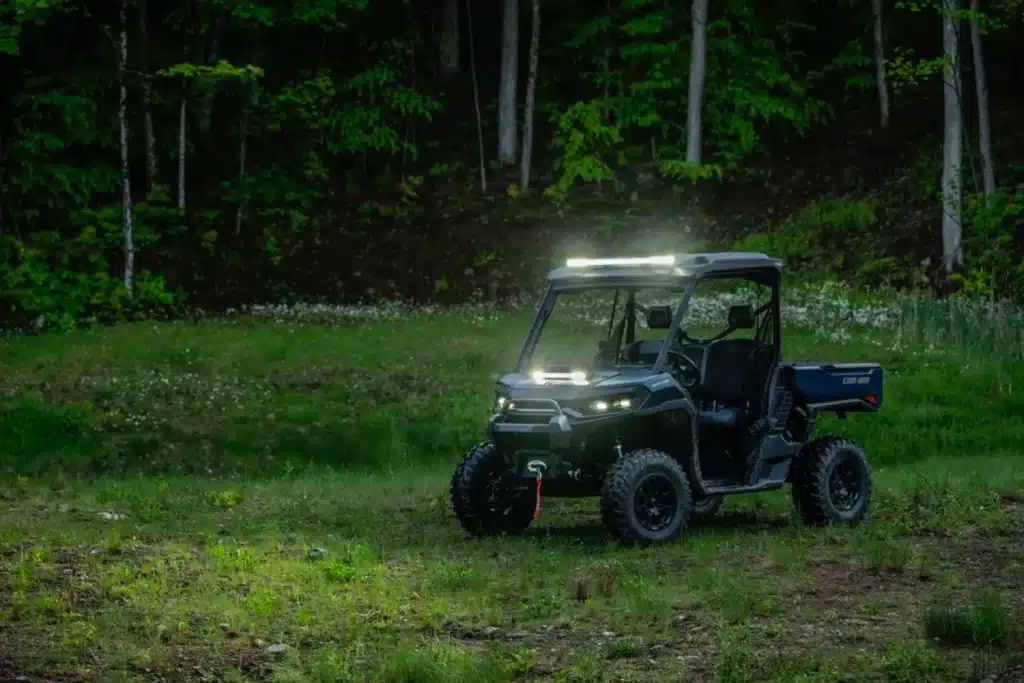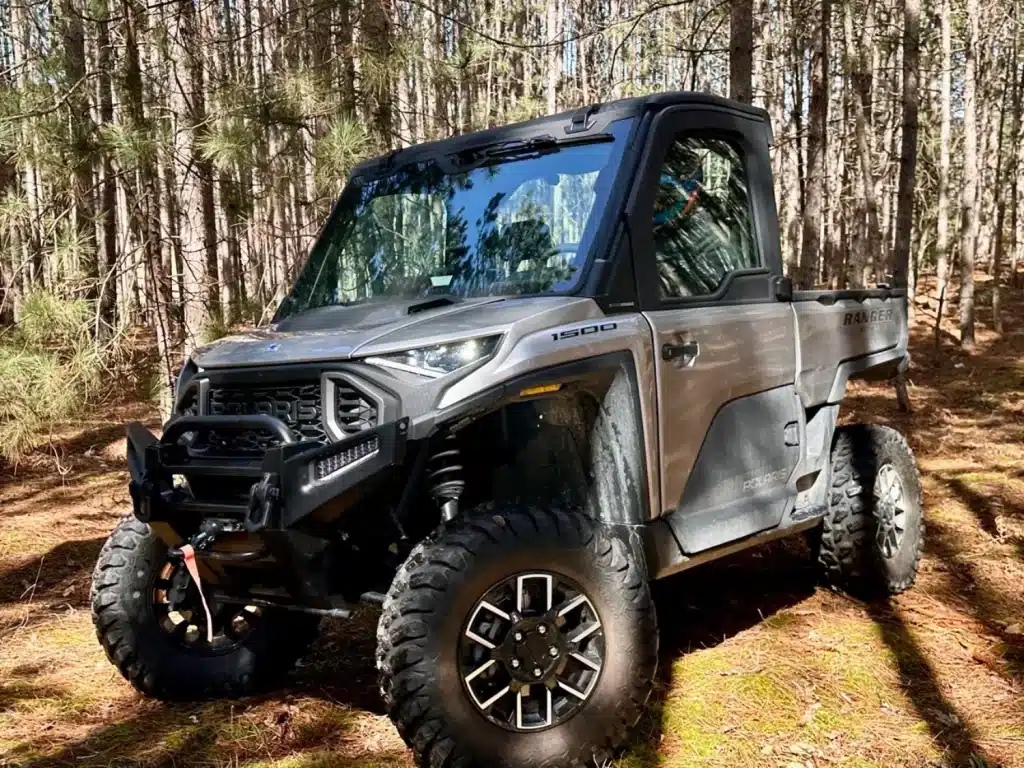For as long as motor vehicles have existed, racing circuits have been the laboratory from which all mechanical innovations and improvements come out of. Specifically designed to push mechanical components and riders to their very limits, the racetrack is and will always be the place to explore the boundaries and find ways to make each aspect of a given machine, the best that it can possibly be.
ATV’s have surely changed quite a bit over the years, and all ATV owners, even utility quad users have racers to thank for providing indispensable feedback to engineers who make improvements found on all different types of vehicles possible. Today’s ATV is a far cry from what was available only 10 years ago and these two totally race inspired rides are at the very top of their game, both with years of racing heritage flowing through them.
Even if your quad only serves you to get to your favorite hunting or fishing spot, its better and safer handling is in large part a reality, because of what is analyzed on the racetrack and this is even more the case now, for example, as the IRS (Independent Rear Suspension) are now used on many racing machines and that utility classes exist.
Growing popularity of the sport of ATV racing in recent years prompted KTM and Can-Am to hop on the wagon with what they call (their race ready quads).
Two powerful rookies
The obvious most popular question to ask when putting these two rookie rides head to head: Which is the most powerful racing machine? We’re as curious as any other and the very first thing we instinctively did was to line up both innovation packed high performance race quads for a few drag races. It felt great to be on the faster KTM and repeatedly getting satisfaction from turning my head and barely catching a glimpse of my momentary rival. The extra punch in the lower end of the more classically carburetted KTM racing 4-stroke, undeniably gave the 450 SX an edge at every gear shift, which translates into an obvious advantage for the all important holeshots and also meant less gear shifting and clutch play was needed to blast out of turns.
Oddly enough though, this noticeable power advantage in the straights didn’t necessarily mean that it would automatically be faster around an entire MX track. I would soon be taken by surprise by the Can-Am’s ability to stay in the fight and even pass the KTM on more complicated grounds to conquer, as it was clearly the smoother and easier to operate of the two. The Can-Am’s power is in its higher level of comfort and predictability and this seemed to count for a lot in sequences of tight turns. One thing quickly became obvious, these two rides stood worlds apart, not only in looks but in feel as well.
If we would do what some call “the pink wire mod”, forcing the DS 450 computer to use its race EFI mapping, which adjusts for better flow on both the intake and exhaust side, the DS would get some extra kick exactly where it needs it most: in the lower end. As with any modifications, this may affect factory or dealer warranty, so check with your dealer first, you don’t want this free mod to turn into expensive repair bills later. One can pull the front plastic off and find a pink wire, which is exposed from the wire harness, and cutting this pink wire and taping it off will automatically enable the computer’s race map. Pulling the air box lid off or cutting into the sides of the box for more intake flow and pulling the baffle out of the exhaust for better exhaust flow is necessary to complete this modification. Obviously, this also would render the quad illegal to use in most trails, but this is not where these puppies should fly, on track performance is what really counts here. Another quick fix for lack of power in the lower revs is to change for a larger gear ratio but whatever you gain in acceleration you lose in top speed. If you choose to do so, dropping only the front sprocket might seem like the cheaper option, but it could pre-maturely wear the chain, as a smaller front sprocket requires the chain to turn at a smaller radius, causing more friction and wear. Putting a larger one at the rear will achieve the same effect but remember that dropping just one tooth up front is equivalent to adding many at the rear.
KTM’S high tech performance engine has a redesigned engine case with a modified ventilation system that accommodates a deep oil sump, allowing better engine performance and an increased oil capacity of 1.8L. Lubrication for the engine, clutch and gearbox uses common oil. KTM claims that their crankshaft drive design maximizes the centrifugal mass and ensures optimum power output, and we believe it! This light and compact package offers surprisingly potent power in its smoothest form possible, with torque equally felt throughout the powerband and ultra precise response from even a minute pressure applied to the thumb throttle. Exhaust is controlled by a lightweight high flow design performance tuned header pipe and modern SX aluminum silencer with integrated filter that was by far louder and punchier than the DS.
To shift or not to shift
Shifting gears and manipulation of the clutch with an all-out race machine is always a crucial part of clocking in good lap times. It is not only important for the rider to master the controls, but also for the machine to respond to his demands in a precise and efficient manner. In this aspect both the KTM and DS were great, but again very different. The clutch on the DS was a bit trickier than the other with a more constant pull at the lever and a little more bite when it grabbed. The shifter on the KTM was a little too short for my taste and was rubbing against the casing, but despite this, gear changes were extremely quick yet smooth and we never missed a shift or fell between gears, which did happen very few times with the DS.
Good brakes can make one go faster
At braking is where these two quads are set the most apart. The feel and behavior of the quadruple piston Magura brakes on the KTM are so much more precise and efficient that first time users should be warned of the controls very sensible feel as much as they should be told to treat the throttle with great respect. The DS just doesn’t have nearly as much precision at the lever, but remains very efficient with its very innovative inverted caliper design intended to lower unsprung weight. Another little extra advantage with the DS and KTM is that it will fit different hand sizes with adjustable levers.
We’re not ready to say that one is better than the other; it really comes down to rider preference. I for one, maybe partly because of my larger size, wasn’t too fond of the KTM’s almost over efficient front brake lever. A minor squeeze would react too harshly for my taste. Actually, I hardly ever have to use the front brakes, but I appreciate how a Pro racer could enjoy and profit from such precise control in a late braking for a pass situation.
So different, yet both oh so nice!
This more precise feel on the KTM brakes repeats itself in many other aspects; power delivery, handling and also suspension, which makes it again a machine much more well- suited for experienced racers than rookies. In my case, being the larger size rider that I am, the DS seemed a much more comfortable and forgiving choice on the track. It is just roomier with the front fenders not blocking me from drooping down the sides as much. I was clocking in better lap times on the DS despite an obvious drop in low end torque in comparison with the throttle happy Austrian orange ride. The tad softer suspension made the ride hug the track a little better and didn’t throw me around nearly as much. This meant a much more relaxed, easier and much more fun time around the track. Steering was easier on the DS and it made a big difference in the longer runs. This general feeling that I was riding much more efficiently on the DS seemed like it was fading out though, as I rode the KTM more and more and harnessed its precision a little better every time out on a track. I was yet to go beyond my first few obvious choices of adjustments in accordance with my hugeness; handlebars at the highest and furthest point, wheels spaced at the max, and delve into the touchier and very important adjustments in the suspension. Surely enough, I got yet a little faster as we set it at what KTM calls in the manual: the comfort setting.
Are they truly race ready?
The term was starting to lose its significance, as many manufacturers were using it profusely, before, it seems, it was actually true. Oddly enough, Can-Am and KTM, those two newest brands to hit the track, seem to be the only ones to finally offer something that really deserves the right to use the term. Standard plus stems and nerf bars, high performance exhaust and number ready plastics, + 2″ double A-arms or option to set the width of the axle to a MX competition style 50 inches, are among the key features giving both of these, a truly race-ready status. Too bad the DS 450X MX still falls short by a simple little thing like the tether kill switch, but is it really? We can clearly see one on many photos on their website but our unit didn’t have any. The DS does have the handlebar cushion though, while the KTM boasts in its place, a disappointingly flimsy plastic cluster to hold the key and warning lights. The DS has interchangeable fenders and detachable headlights while the KTM boasts plastics designed for racing, which are easy to remove for chassis and engine service and removable front fender for specific race applications.
Both offer an amazing amount of user input possibilities, more importantly at the suspension level, always a key factor in competitiveness. Adjustable camber, caster and toe angles at the front wheels will permit very different type riders to tune it just right, according to different racing applications and/or their preferences. Both machines use different principles to achieve precision in these choices, through the repositioning of numerous parts in the system. Camber changes on the DS are done through shims at the ball joint, while the KTM uses a screw and lock system at both pivot points of each A-arm. Camber is the tilting of the wheels from the vertical when viewed from the front of the vehicle. When the wheels tilt outward at the top, the camber is positive (+). When the wheel tilts inward at the top, the camber is negative (-). Oval racers will sometimes use excessive negative camber to harness the outside tire’s entire grip pattern, as they keep it at a vertical position while in a turn.
Castor or caster is the angular displacement from the vertical axis of the suspension of a steered Wheel, meaning that when the wheel hits an obstacle, it moves back as it moves up. A good example of extreme caster angle would be the front suspension on a chopper motorcycle. Caster provides a degree of self-centering for the steering, reducing the vehicle’s tendency to wander. Excessive caster angle will make the steering heavier and less responsive. The KTM’s caster angle is adjustable, as on the Can-Am, by the placement of shims on one side or the other of the inner bolts of the upper A-arms, but the DS offers a much more precise adjustment with a greater number of smaller shims. Each shim represents one-degree of adjustment with camber adjustable from 11 degrees to 15 degrees; caster is adjustable from 3 degrees to 10 degrees.
They both also use shims at the rear axle to achieve different width. That dimension choice on the KTM is again much less varied with only one wide shim to each side, while the DS has a total of four half inch shims on each side that one can distribute as he wishes on the inside and outside of the wheel hub units. We, of course, simply set both at the max 50 inches as soon as we got our hands on them.
Suspension
The Can-Am DS 450X MX uses large-diameter Kashima-coated high-pressure aluminum KYB HPG C40 gas shocks with dual-speed compression, rebound and preload adjustments. A very odd thing about its dual springs though, is that the small top springs on our Can-Am unit, which should normally take care of softly cushioning the beginning of the total 10.7 inches of travel by being first compressed by the main spring under it, a nice but not really necessary feature, were totally squished even when the ride was just parked with nobody on it, and I wondered if only our unit was like this. After looking at as many photos as possible on the web, it seemed to be the case on most units with the weird exception of a few pictures I found where you could distinguish a true spring there. These top springs would normally smooth out the ride quite a bit when speeding over small imperfections on the ground. Regardless, coupled with the same 10.7 inches of travel at the rear, with a C46 KYB, the ride was awesomely smooth in the rough and very forgiving when launching and landing jumps.
The KTM’s exclusive WP suspension uses fully adjustable piggyback suspension elements with high/low speed compression, preload and rebound adjustments and dual rate springs with adjustable crossover. The top springs on this ride were much more logically spread over a few inches and truly playing a role in cutting down vibrations at higher speeds. The main springs on the DS were obviously softer and didn’t need as much assistance in smoothing out smaller bumps and holes but the dual rate action was clearly better designed on the KTM. This here package offers an inch less than the other with 9.6 in. of front wheel travel, but we didn’t feel it to be a disadvantage as bottoming out was still more of a rare occurrence on the KTM. At the rear, we find just a bit less travel than on the DS with 10.4″. The SX has a strong chromoly steel swingarm with eccentric chain adjuster, a chromoly rear axle with high quality and easy to lubricate tapered roller bearings and a new shock anchorage point for MX application with 10 mm longer shaft travel. Self locking rear axle nuts are used for quick tire changes. WP’s “Progressive Damping System” (PDS) single shock with preload, high and low speed compression and rebound adjustment is an industry exclusive dual rate springs with adjustable crossover, which allows a no linkage design for reduced weight, maximum ground clearance and easier maintenance.
Tires and wheels
In the tire department, which is the other crucial aspect with this type of technologically advanced Motocross racing-specific designed machines, our beloved KTM (well, at least for a few weeks of pounding) relied on 20×6-10 front and 18×10-8 Maxxis Razr soft-comp tires. We’ve never captured such tire deformation in a photo! Looking like a boiling hot drag racing rubber, combating the considerable forces threatening its integrity, it bends and crumples under the intense pressure. We were running them as they set them for us; 3lbs of air pressure, and still seemed to be losing the back end quite easily, in long swooping curves. No way could we muster a little more grip out of them by dropping below 3lbs, which is already the all-around minimum for ATV tires.
These Razr tires are wrapped around wheels designed exclusively for KTM by Douglas Technologies Group, Inc. These lightweight and durable aluminum wheels seemed more able to take our abuse than those of the Can-Am, but that’s a tough call since nobody can say that both machines suffered exactly the same amount or type of abuse. One thing is certain, the KTM’s Razr tires do stick outside the rim a bit more and so offer better protection to its wheels. The Can-Am wears ITP QuadCross MX Pro tires to communicate with the ground which seemed just a little more efficient than the Razr’s in the loose stuff. When drag racing both machines on softer grounds, the KTM wasn’t stretching out up front as much and we suspected the extra cavities in each thread on the ITP’s to be responsible for this. We also placed four cones in a very tight circle on gravel and ran after each other. Both machines seemed to go the same speed and just when I thought I could catch up to the DS with a little extra push, I would lose the back end. We kept this dizzying test going for a good while as we would switch machines from time to time, and the same thing happened over and over.
It doesn’t get any closer than this
Our KTM’s inverted air filter was accessible in a flash, but its battery was a pain to get to. The sprocket on our DS was getting loose on us and we had to add adhesive to the bolts. They both had a few simple pet peeves like a rear grab bar set so high that it’s almost useless on the Can-Am, or rear fender brackets that were causing some whitening of the plastic just from normal riding on the KTM (I strongly suggest you remove those, my friend Pat took his off and everything stayed solidly in place with just the right amount of flexibility), but truth is both machines truly pleased us beyond expectations and riding and racing them both was amazingly fun, while harnessing all of their powers was terrifically challenging and educational. On the maintenance side of things, the DS seemed a bit more user friendly with things like quick and easier access to the battery right under the seat and Electronic Fuel Injection, which did make start-ups more constant and predictable at all times without the need for any human intervention.
Experienced racers will love this fast and precise puppy. KTM has truly built a stock ATV that is capable of keeping its brave rider competitive at the highest levels in racing with hardly anything needing to be touched. Overall, the bright orange and stealthier looking KTM seems to be the winner in many aspects of performance and both are equal in value despite the higher price of the KTM (10,749$ for the Can-Am and 11,598$ for the KTM). A little bit of racing upgrade budget should bring the DS more up to speed with the KTM. The Can-Am might appeal to a broader spectrum of riders with its easier operation, higher comfort level, easy maintenance and more user friendly fuel injected engine. Taking all factors in consideration, this bout actually looks more like a tie.


